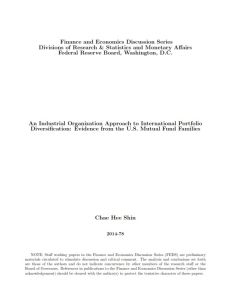Join getAbstract to access the summary!

Join getAbstract to access the summary!
Chae Hee Shin
An Industrial Organization Approach to International Portfolio Diversification
Evidence from the US Mutual Fund Families
Federal Reserve Board, 2014
What's inside?
Most investors tend to underdiversify internationally. Understanding the US mutual fund industry may help explain why.
Recommendation
Mutual funds are not immune from “home bias” – the tendency of investors not to venture outside their local markets. Economist Chae Hee Shin of the Federal Reserve reveals what may be behind this financial xenophobia. While this study provides new insights into why many US mutual fund families stick to certain parts of the globe, it fails to mention such pertinent factors as the relative performance of global markets or the increased use of indexing strategies that emphasize market-capitalization weightings. Nonetheless, getAbstract recommends this eye-opening analysis to financial industry professionals and investors everywhere.
Summary
About the Author
Chae Hee Shin, an economist at the Federal Reserve Board of Governors.


















Comment on this summary